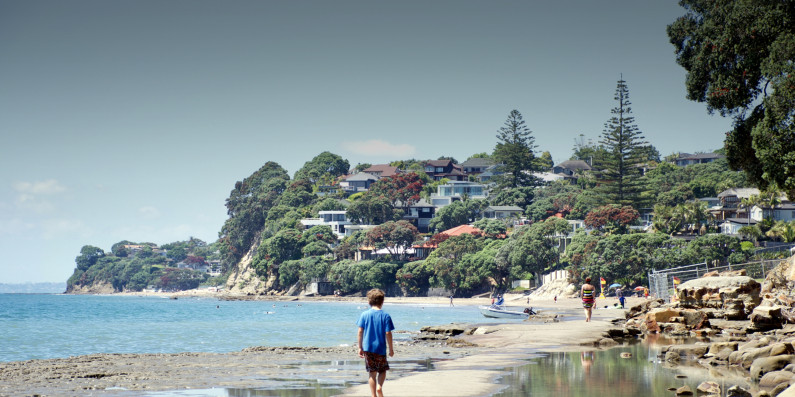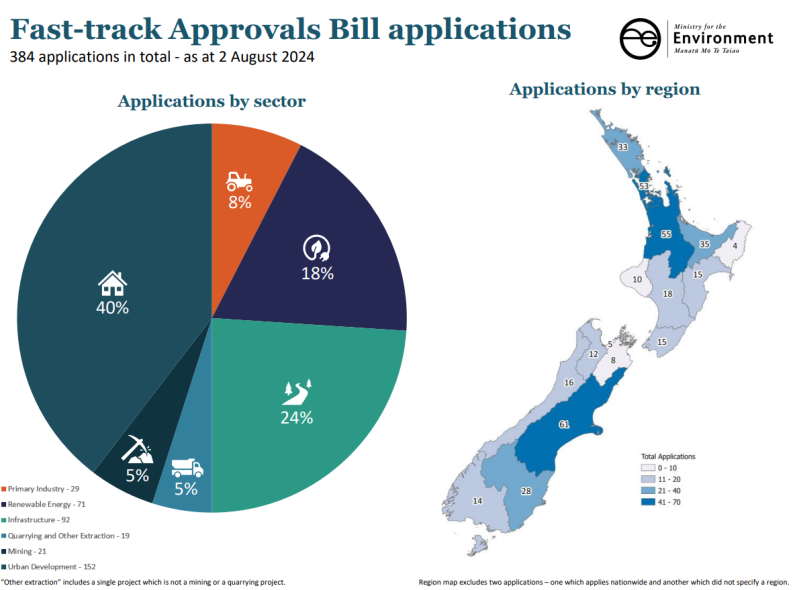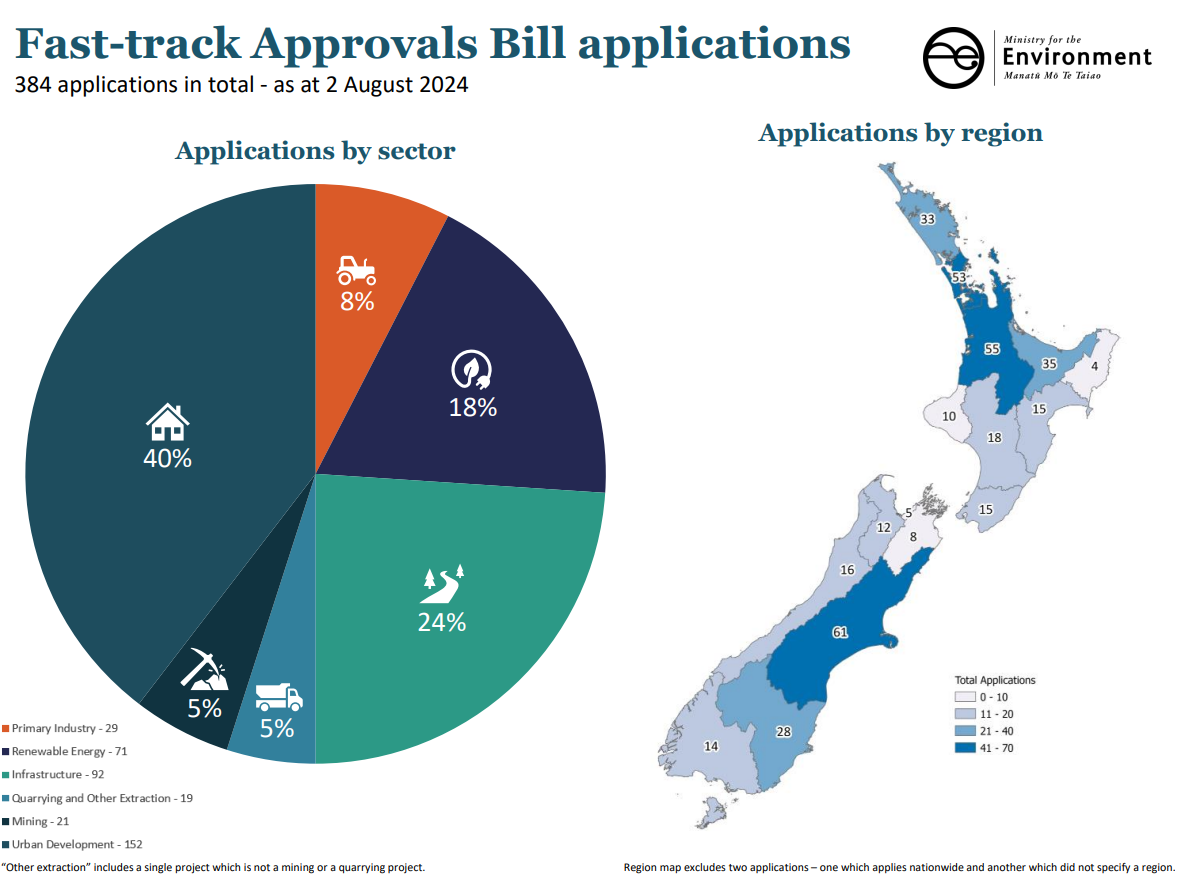
RM reform update - September 2024 Twenty-First edition
The RM Reform update is for people and organisations with an interest in the reform of the resource management system. If you would like to subscribe to these updates, please click here.

The RM Reform update is for people and organisations with an interest in the reform of the resource management system. If you would like to subscribe to these updates, please click here.
Kia ora koutou,
The Government has made several recent announcements outlining the next steps in its resource management reform programme.
Among these were proposed changes to the Fast-track Approvals Bill and the introduction of a second bill to make targeted amendments to the Resource Management Act (RMA).
As with the recently introduced Resource Management (Freshwater and Other Matters) Amendment Bill, the proposed second RMA bill will be focused on addressing the most immediate resource management issues to enable growth in infrastructure, renewable energy and housing and other development sectors.
Alongside the second bill, the Government says seven new National Direction instruments – referred to as national policy statements (NPS) and national environmental standards (NES) – will be developed and 14 existing instruments will be amended.
The changes will be bundled into four packages. An Energy and Infrastructure package – which includes the Government’s Electrify NZ plan, announced on 26 August – will see amendments to the NES for Telecommunications Facilities, and an NPS for infrastructure introduced.
A Housing package will include amendments to the NPS - Urban Development and NPS - Highly Productive Land and other changes aimed at enabling housing and papakāinga development and changes to the way heritage buildings are managed in urban planning.
A third package for the Farming and the Primary Sector includes proposals relating to freshwater, indigenous biodiversity, commercial forestry and marine aquaculture.
A fourth package, Emergencies and Natural Hazards, focusses on providing a comprehensive, nationally consistent framework for addressing the risks posed by these hazards, including increased risk from climate change.
MfE is a lead agency for these work programmes and will keep you up to date on legislative developments and opportunities to provide feedback.
Ngā mihi nui, nā
Nadeine Dommisse,
Deputy Secretary, Environment Management and Adaptation
The Government last week announced it was recommending changes to the Fast-track Approvals Bill (FTA Bill).
On Sunday 25 August, RMA Reform Minister Chris Bishop and Regional Development Minister Shane Jones said several recent Cabinet recommendations would be referred to the Environment Select Committee. The Committee is currently reviewing the Bill and is due to report back to the House of Representatives in October.
Cabinet's recommended changes were that:
The Environment Select Committee will decide whether to accept these recommendations before delivering its report. The FTA Bill could become law in late 2024.
Read the Government’s full press release here: Huge interest in one-stop shop Fast-track Bill [Beehive.govt.nz]
The Government has announced that 384 applications to list projects in Schedule 2 of the Fast-track Approvals Bill (FTA Bill) were assessed by an independent Fast-track Projects Advisory Group by 2 August.
By sector, applications were for:
Listed projects process
The independent Fast-track Projects Advisory Group assessed applications and reported back to Ministers in early August recommending projects to be listed in the Bill.
Cabinet will make the final decisions on which FTA Bill schedule projects will be listed in before it returns to Parliament for its final reading. The FTA Bill could become law in late 2024.

Fast tract Approvals Bill applications
The total number of applications is 384 as of August 2, 2024.
Urban development 152(40% )
Infrastructure 92 (24%)
Renewable Energy 71 ( 18%)
Primary industry 29 (8%)
Mining 21 (5%)
Quarrying and Other Extraction 19 (5%)
"Other extraction" includes a single project which is not mining or a quarrying project.
Total Applications
0 - 10 Marlborough, Taranaki, Gisborne
11 - 20 Nelson, West coast, Southland, Manawatu -Whanganui, Wellington, Hawke's Bay
21 - 40 Otago, Bay of Plenty, Northland
41 - 70 Auckland, Canterbury
Region map excludes two applications - one which applies nationwide and another which did not specify a region.

Fast tract Approvals Bill applications
The total number of applications is 384 as of August 2, 2024.
Urban development 152(40% )
Infrastructure 92 (24%)
Renewable Energy 71 ( 18%)
Primary industry 29 (8%)
Mining 21 (5%)
Quarrying and Other Extraction 19 (5%)
"Other extraction" includes a single project which is not mining or a quarrying project.
Total Applications
0 - 10 Marlborough, Taranaki, Gisborne
11 - 20 Nelson, West coast, Southland, Manawatu -Whanganui, Wellington, Hawke's Bay
21 - 40 Otago, Bay of Plenty, Northland
41 - 70 Auckland, Canterbury
Region map excludes two applications - one which applies nationwide and another which did not specify a region.
The Government has announced plans for a second bill to make targeted amendments to the Resource Management Act 1991.
The bill is due to be introduced to Parliament later this year and could become law in 2025.
The key proposals being considered, by package, are to:
Infrastructure
Housing
Emergencies and Natural Hazards
Systems Improvements
The Government has indicated it will make further farming and primary sector package announcements in coming months.
The proposals were announced at the Local Government New Zealand Conference on 22 August. A comparison with proposed national direction changes is available here.
The Coalition Government has outlined its plan to make it easier and cheaper to consent, build and maintain renewable electricity generation, distribution and transmission.
Electrifying New Zealand’s economy is a key part of the Government’s plan to grow the economy, strengthen energy security and reduce emissions to achieve Net Zero 2050.
Announced on 26 August, the Electrify NZ plan involves fundamental changes to planning and regulatory settings. The Government's proposed plan would:
The Government plans to make these changes through the second Resource Management Act amendment bill later this year. It also plans to:
Read the Government press release here.
Thank you to all who made submissions last year on proposals for a two-phase approach to direct councils to consistently manage risks from floods, landslides and other natural hazards when planning new land use activities under the RMA.
We received 102 submissions. Overall, there was support for the intention of the proposals, but some submitters considered that it would be more workable to make changes once rather than repeatedly.
The Government has therefore decided to progress National Direction for Natural Hazards through a single instrument, to be in place by mid-2025.
The national direction will be advanced through phase two of the Government's Resource Management Act reform programme.
There will be further opportunity to contribute to the development of natural hazards policy through the public consultation process for phase two.
Read the summary of submissions here.
The Government is proposing temporary law changes to make it easier to undertake flood works in Māngere, to improve the community’s resilience to severe weather events.
Māngere was particularly affected by the 2023 Auckland Anniversary floods and Cyclone Gabrielle. After these events homeowners were concerned about the impact of future severe weather events. Developing new culverts, dams and other infrastructure will help to improve the flood resilience in these communities.
The proposed law changes would enable Auckland Council to get on with the job of constructing these flood works this summer. Learn more on the Ministry website.
Changes to the National Policy Statement for Highly Productive Land 2022 (NPS-HPL) will come into effect on 13 September to enable a consenting path for new renewable energy projects, indoor primary production (such as poultry and piggeries) and greenhouses.
Since the NPS-HPL took effect in 2022, some in the agriculture, horticulture, and renewable energy sectors have raised concerns about it restricting activities on highly productive land.
Further changes to the NPS-HPL will be considered as part of the Government’s reform of the resource management system.
The MfE and Ministry for Primary Industries would like to acknowledge everyone’s contributions throughout the consultation and amendment process. For more click here.
The requirements for councils to free up more capacity for housing have been decided by the Government as part of its Going for Housing Growth plan. The changes, expected to be in place by mid-2025, will be made through amendments to the Resource Management Act and the National Policy Statement on Urban Development. Formal public consultation on the detailed design changes will occur in early 2025.
The decisions include:
For more see the Ministry of Housing and Urban Development page here.
A new report indicates organisations who responded to a call for data on adaptation preparedness are more prepared for climate change now than they were four years ago.
Earlier this year, the Climate Change Minister asked organisations that contribute to the resilience of essential infrastructure for information about how prepared they are to adapt. The information enables progress to be tracked, and organisations to share any barriers to action or opportunities for acceleration.
A summary report of the responses, including key trends and changes since the baseline report in 2020, is available here.
He Pou a Rangi - Climate Change Commission has released its first monitoring reports on emissions reductions and New Zealand’s national adaptation plan.
The annual monitoring report on emissions reductions assesses progress against New Zealand’s 2050 target, emissions budgets and the first emissions reduction plan, and can be found here.
The report on the national adaptation plan, which will be delivered every two years, assesses the plan’s implementation and effectiveness, and can be found here.